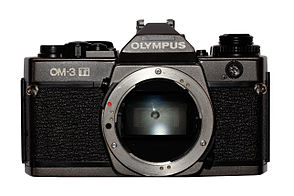Olympus OM-3 Ti
| Olympus OM-3 Ti | |

|
|
| Type: | single-lens single-lens reflex camera |
| Production period: | 1995-2002 |
| Lens connection : | Olympus OM bayonet |
| Film format : | 35 mm (small picture) |
| Recording format : | 24 × 36 mm (small picture) |
| Viewfinder : | Pentaprism finder with Fresnel lens, diopter correction -3 - +1 |
| Viewfinder field: | 97% |
| Enlargement: | 0.84 times |
| Finder Ads: | Bar display of shutter speeds from 1 - 1/2000 s in 1/3 f-stop steps; Over and
Underexposure warning; "+/-" display for manual measurement; Flash readiness (green LED); "correct" flash exposure ("blinking" of the green LED); Exposure mode (spot / integral metering) |
| Operating modes: | Manual control through tracking measurement with open aperture measurement. Spot measurement (2%) as single and multi-spot measurement (maximum 8 points), high-key and low-key button (in spot mode) |
| Film transport: | manual or motorized (winder / motor) |
| Exposure metering : | TTL open aperture measurement with lenses from the OM system. With tracking measurement center-weighted integral (for flash measurement autodynamically on shutter curtain or film surface), spot measurement (approx. 2% of the image field via silicon measuring cell) in 3 operating modes: multi-spot measurement (max. 8 measurement points), light or shadow emphasis (high- Key and low key button) |
| Measuring range: | EV -1 - 19 (at 100 ISO - with the Zuiko Auto-S 50 mm f / 1.2) |
| Regulation: | Tracking principle: aperture preselection or time preselection |
| Correction : | +/- 2 f-stops in 1/3 steps |
| Closure : | mechanically controlled cloth closure (horizontal) |
| Shutter speed : | 1/2000 to 1 s, B. |
| Flash control: | TTL auto flash (OTF auto flash) automatically, up to 9 Olympus T flash units can be ignited and controlled simultaneously |
| Lightning connection : | Hot shoe (with X and linear flash contacts) and 5-pin connection socket |
| Synchronization : | 1 / 60s and longer or with Olympus F280 flash unit: 1 / 60-1 / 2000s |
| Power supply: | 2 × SR44 / LR44, test (LED and acoustic signal) |
| Dimensions: | 136 × 84 × 50 mm |
| Weight: | 510 g |
The Olympus OM-3 Ti was launched in 1995 and was built until 2002. It was the revised successor to the Olympus OM-3 and the last camera of the analog Olympus OM system . The OM-3 Ti was the first fully mechanical camera to fully integrate TTL flash technology. The measurement is carried out "autodynamically" directly on the shutter curtain or on the film surface during exposure. Thanks to the autodynamic measuring system, the camera reacts directly to changed lighting conditions and uses this technology to achieve extremely precise flash exposures.
Like its sister camera, the Olympus OM-4 Ti , which is equipped with automatic exposure , the OM-3 Ti has an extremely sophisticated exposure metering system with multi-spot metering (up to 8 measuring points can be combined into one measurement). The measurement is carried out by a silicon photodiode and covers approx. 2% of the image field. There are also highlight and shadow buttons for very light and very dark motifs.
The camera was designed for professional use and accordingly integrated into an extensive system of accessories. In order to meet the tough requirements of professional use, the top cap and the base plate of the camera are made of durable titanium. For additional protection, the surface was given an elaborate, anti-reflective special coating that also gives it an unmistakable look. The camera only needs battery power to measure the exposure and works without power.
equipment
Camera drives
- Motor Drive : The OM system has Motor Drive 1 and Motor Drive 2. Both allow film transports up to 5 frames / second. The Motor Drive 2 also offers motorized film rewind. The following energy sources are available for the Motor Drives: NiCd pack (15 V), battery handle (18 V, for 12 batteries or rechargeable batteries of size AA), control unit with mains connection
- Winder : The OM system includes Winder 1 and Winder 2. Winder 1 only offers single image recordings, while Winder 2 also offers series images with up to 2.5 images / second. The winders do not offer automatic film rewind.
Camera back panels
The standard rear panel can be exchanged for the following rear panels:
- OM data back wall: a back wall for imprinting the date, time and exposure data (Recorddata Back 4).
- Feature film magazines: Magazines 1 and 2 for film material for up to 250 exposures.
Focusing screens
16 interchangeable types of focusing screens, from the full focusing screen to the version with cross-section / microprism ring. The focusing screens are changed by the lens bayonet. The OM-3 Ti is equipped as standard with the newly developed Lumi Micron focusing screen, which, thanks to its increased brightness and extremely fine grain, allows precise focusing even in difficult lighting conditions.
Flash units
In the OM system there are several flash units with different characteristics. Particularly noteworthy is the Olympus F280 fully synchronous flash unit, which offers flash sync times between 1 / 60s and 1 / 2000s in FP mode.
Remote release accessories
There are a number of accessories available for remote control of the OM-3 Ti, such as: B. Remote release cable, the M. Quartz remote release, etc.
literature
- Olympus OM-3 Ti operating instructions (German), no date
- Olympus OM-3 Ti information brochure (German), 11/94
Web links
- Commons : Olympus OM-3 - collection of images, videos and audio files
- Olypedia overview of the OM system [1]
